Chapter: Transmission and Distribution : Insulators and Cables
Types of Insulator
TYPES OF INSULATOR
There are mainly three types of insulator likewise
1. Pin Insulator
2. Suspension Insulator
3. Stray Insulator
4. Shackle Insulators
5. Stay Insulator
In addition to that there are other two types of electrical insulator available mainly for low voltage application, e.i. stay insulator and shackle insulator.
1. Pin Type Insulators
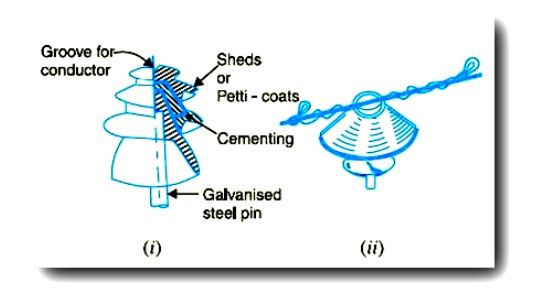
As the name suggests, the pin type insulator is secured to the cross-arm on the pole. There is a groove on the upper end of the insulator for housing the conductor. The conductor passes through this groove and is bound by the annealed wire of the same material as the conductor. Pin type insulators are used for transmission and distribution of electric power at voltages up to 33 kV. Beyond operating voltage of 33 kV, the pin type insulators become too bulky and hence uneconomical.
Causes of Insulator Failures:
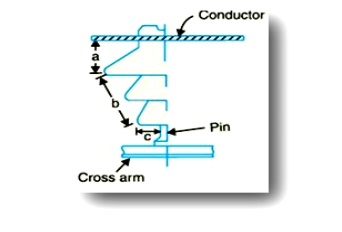
Insulators are required to withstand both mechanical and electrical stresses. The latter type is primarily due to line voltage and may cause the breakdown of the insulator. The electrical breakdown of the insulator can occur either by flash-over or puncture. In flashover, an arc occurs between the line conductor and insulator pin (i.e., earth) and the discharge jumps across the air gaps, following shortest distance. Figure shows thearcingdistance (i.e. a + b + c) for the insulator. In case of flash-over, the insulator will continue to act in its proper capacity unless extreme heat produced by the arc destroys the insulator. In case of puncture, the discharge occurs from conductor to pin through the body of the insulator. When such breakdown is involved, the insulator is permanently destroyed due to excessive heat. In practice, sufficient thickness of porcelain is provided in the insulator to avoid puncture by the line voltage. The ratio of puncture strength to flashover voltage is known as safety factor.
2. Suspension Type
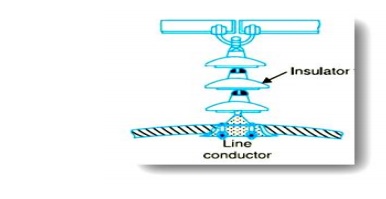
For high voltages (>33 kV), it is a usual practice to use suspension type insulators shown in Figure. Consist of a number of porcelain discs connected in series by metal links in the form of a string. The conductor is suspended at the bottom end of this string while the other end of the string is secured to the cross-arm of the tower. Each unit or disc is designed for low voltage, say 11 kV. The number of discs in series would obviously depend upon the working voltage. For instance, if the working voltage is 66 kV, then six discs in series will be provided on the string.
Advantages of suspension type:
Suspension type insulators are cheaper than pin type insulators for voltages beyond 33 kV.
Each unit or disc of suspension type insulator is designed for low voltage, usually 11 kV. Depending upon the working voltage, the desired number of discs can be connected in series.
If anyone disc is damaged, the whole string does not become useless because the damaged disc can be replaced.
The suspension arrangement provides greater flexibility to the line. The connection at the cross arm is such that insulator string is free to swing in any direction and can take up the position where mechanical stresses are minimum.
In case of increased demand on the transmission line, it is found more satisfactory to supply the greater demand by raising the line voltage than to provide another set of conductors. The additional insulation required for the raised voltage can be easily obtained in the suspension arrangement by adding the desired number of discs.
The suspension type insulators are generally used with steel towers. As the conductors run below the earthed cross-arm of the tower, therefore, this arrangement provides partial protection from lightning.
3. Strain Insulators
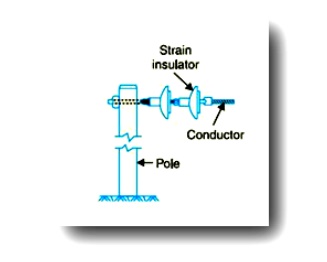
When there is a dead end of the line or there is corner or sharp curve, the line is subjected to greater tension. In order to relieve the line of excessive tension, strain insulators are used. For low voltage lines (< 11 kV), shackle insulators are used as strain insulators. However, for high voltage transmission lines, strain insulator consists of an assembly of suspension insulators as shown in Figure. The discs of strain insulators are used in the vertical plane. When the tension in lines is exceedingly high, at long river spans, two or more strings are used in parallel.
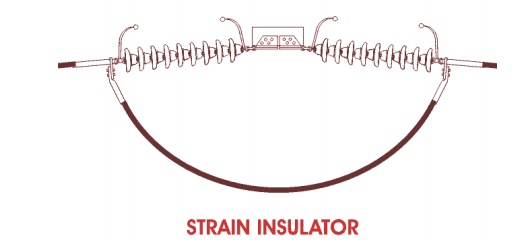
4. Shackle Insulators
In early days, the shackle insulators were used as strain insulators. But now a day, they are frequently used for low voltage distribution lines. Such insulators can be used either in a horizontal position or in a vertical position. They can be directly fixed to the pole with a bolt or to the cross arm.
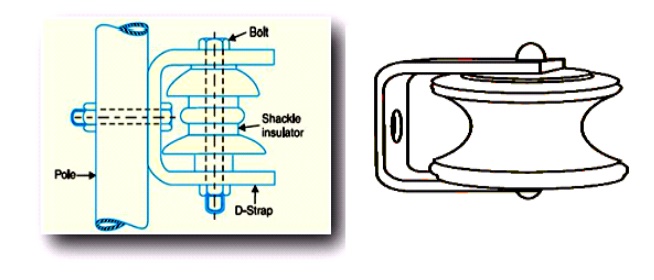
5. Stay Insulator
For low voltage lines, the stays are to be insulated from ground at a height. The insulator used in the stay wire is called as the stay insulator and is usually of porcelain and is so designed that in case of breakage of the insulator the guy-wire will not fall to the ground. There are several methods of increasing the string efficiency or improving voltage distribution across different units of a string.

Related Topics